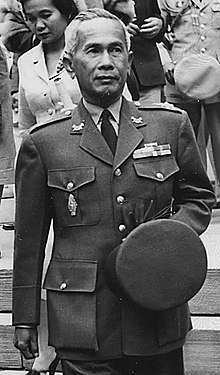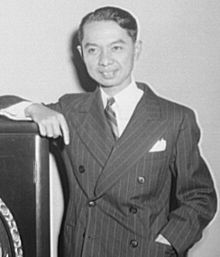--
Militarism versus Reform
The designated
heir was Prince Ananda Mahidol, a nephew of Prajadhipok. As the young prince was only ten years old
and studying abroad, he would not be a factor in Siam’s politics for at least a
decade. The power vacuum this created
was filled by both the military and intellectuals, led by Phibun and Pridi,
respectively. Phibun took control, and
at this point changed the name of the country to Thailand.
Phibun and his
supporters were openly enamored with the strength of the militant nationalism
espoused by Italy, Germany and Japan. Further,
the Thai felt a kinship with the Japanese as their two countries were the only
ones in Asia that had escaped European colonization during the 19th
century. Despite this, he did not have
any desire to enter a war between the Allied and Axis powers and strove to keep
a balance between the two interests in Thailand. However, once France capitulated to Germany in
1941, Phibun took the opportunity to snatch back the parts of French Cambodia
that had been lost to them in 1893.
Japan sweetened the deal with Thailand by giving them territory to the
north and east of their borders.
.jpg/220px-Pridi_Panomyong_(Scholar).jpg) |
| Pridi Banomyong |
Thailand’s
entrance into World War II on the side of the Japanese was complicated. On one
hand, Phibun was hopeful that if Japan could use Thailand as a base they would
be able to gain back more “lost” territory.
Indeed, they did regain territory from Burma and Malay in 1943. On the other hand, resisting the Japanese
would have been disastrous. After Japan’s
initial request to use Thailand as a base in December of 1941, Phibun’s aides
attempted to delay giving an answer for a day.
However, when Thailand was invaded at nine different points on the same
day that the Japanese struck, infamously, at Pearl Harbor, the Thai felt they
had no choice but to comply with the Japanese terms.
Initially, Phibun
imagined that Thailand could be a partner with Japan that would throw off the
hated European colonialists. However, it
quickly became apparent that the Japanese saw Thailand as an occupied country and
not an ally. They forced the Thai government
to make “loans” to them and used their supplies for their war effort.
 |
| Plaek Phibunsongkhram (Phibun) |
The war alienated
the civil leaders, such as Pridi, from the militaristic followers of
Phibun. Nevertheless, when it was
apparent by 1943 that Japan would not be victorious, both factions began to
make contacts with the Allies to undermine the Japanese. They were joined by Seni Pramoj, a member of
the royal family who was serving as the ambassador to the United States and had
refused to serve the notice of war to the American government. These efforts came together in the Seri Thai
(Free Thai) movement.
 |
| Seni Pramoj |
By 1944, Pridi’s civilian group took power from Phibun, in part to improve their chances with the Allies after the foreseeable Axis loss. This maneuver did in fact help the Thai when the British and French, indignant over the manner in which the Thai had taken advantage of their weaknesses during the war, demanded retribution. The United States, which had never officially been at war with Thailand, instead insisted that it be treated as an enemy-occupied state. After Pramoj was invited to return to Thailand as Prime Minister, the British were convinced to settle for a compensation of rice and the return to pre-war boundaries. These negotiations were the beginning of the strong ties between the US and Thailand.
© Suzanne Nam.
--
Want to read more? Please check out Moon Thailand (Moon Handbooks) by Suzanne Nam





